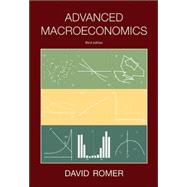
| Preface to the Third Edition | xvii | ||||
| Introduction | 1 | (4) | |||
| Chapter 1 THE SOLOW GROWTH MODEL | 5 | (43) | |||
|
5 | (4) | |||
|
9 | (5) | |||
|
14 | (3) | |||
|
17 | (5) | |||
|
22 | (4) | |||
|
26 | (3) | |||
|
29 | (8) | |||
|
37 | (7) | |||
|
44 | (4) | |||
| Chapter 2 INFINITE-HORIZON AND OVERLAPPING-GENERATIONS MODELS | 48 | (52) | |||
|
48 | (28) | |||
|
48 | (2) | |||
|
50 | (6) | |||
|
56 | (6) | |||
|
62 | (1) | |||
|
63 | (2) | |||
|
65 | (5) | |||
|
70 | (6) | |||
|
76 | (16) | |||
|
76 | (1) | |||
|
77 | (3) | |||
|
80 | (7) | |||
|
87 | (4) | |||
|
91 | (1) | |||
|
92 | (8) | |||
| Chapter 3 NEW GROWTH THEORY | 100 | (74) | |||
|
101 | (31) | |||
|
101 | (2) | |||
|
103 | (5) | |||
|
108 | (7) | |||
|
115 | (7) | |||
|
122 | (3) | |||
|
125 | (2) | |||
|
127 | (5) | |||
|
132 | (34) | |||
|
133 | (5) | |||
|
138 | (6) | |||
|
144 | (10) | |||
|
154 | (7) | |||
|
161 | (5) | |||
|
166 | (8) | |||
| Chapter 4 REAL-BUSINESS-CYCLE THEORY | 174 | (48) | |||
|
174 | (4) | |||
|
178 | (2) | |||
|
180 | (3) | |||
|
183 | (4) | |||
|
187 | (5) | |||
|
192 | (5) | |||
|
197 | (6) | |||
|
203 | (5) | |||
|
208 | (2) | |||
|
210 | (6) | |||
|
216 | (6) | |||
| Chapter 5 TRADITIONAL KEYNESIAN THEORIES OF FLUCTUATIONS | 222 | (49) | |||
|
223 | (8) | |||
|
231 | (11) | |||
|
242 | (9) | |||
|
251 | (7) | |||
|
258 | (6) | |||
|
264 | (2) | |||
|
266 | (5) | |||
| Chapter 6 MICROECONOMIC FOUNDATIONS OF INCOMPLETE NOMINAL ADJUSTMENT | 271 | (75) | |||
|
272 | (13) | |||
|
273 | (3) | |||
|
276 | (4) | |||
|
280 | (5) | |||
|
285 | (24) | |||
|
286 | (4) | |||
|
290 | (4) | |||
|
294 | (9) | |||
|
303 | (6) | |||
|
309 | (30) | |||
|
310 | (6) | |||
|
316 | (3) | |||
|
319 | (7) | |||
|
326 | (2) | |||
|
328 | (5) | |||
|
333 | (6) | |||
|
339 | (7) | |||
| Chapter 7 CONSUMPTION | 346 | (40) | |||
|
347 | (6) | |||
|
353 | (3) | |||
|
356 | (5) | |||
|
361 | (5) | |||
|
366 | (4) | |||
|
370 | (10) | |||
|
380 | (6) | |||
| Chapter 8 INVESTMENT | 386 | (51) | |||
|
386 | (3) | |||
|
389 | (6) | |||
|
395 | (1) | |||
|
396 | (4) | |||
|
400 | (6) | |||
|
406 | (3) | |||
|
409 | (4) | |||
|
413 | (4) | |||
|
417 | (11) | |||
|
428 | (5) | |||
|
433 | (4) | |||
| Chapter 9 UNEMPLOYMENT | 437 | (59) | |||
|
437 | (2) | |||
|
439 | (5) | |||
|
444 | (4) | |||
|
448 | (12) | |||
|
460 | (4) | |||
|
464 | (3) | |||
|
467 | (5) | |||
|
472 | (9) | |||
|
481 | (8) | |||
|
489 | (7) | |||
| Chapter 10 INFLATION AND MONETARY POLICY | 496 | (63) | |||
|
497 | (4) | |||
|
501 | (5) | |||
|
506 | (4) | |||
|
510 | (10) | |||
|
520 | (5) | |||
|
525 | (8) | |||
|
533 | (5) | |||
|
538 | (9) | |||
|
547 | (5) | |||
|
552 | (7) | |||
| Chapter 11 BUDGET DEFICITS AND FISCAL POLICY | 559 | (60) | |||
|
560 | (7) | |||
|
567 | (2) | |||
|
569 | (4) | |||
|
573 | (6) | |||
|
579 | (3) | |||
|
582 | (10) | |||
|
592 | (6) | |||
|
598 | (5) | |||
|
603 | (4) | |||
|
607 | (6) | |||
|
613 | (6) | |||
| References | 619 | (37) | |||
| Author Index | 656 | (7) | |||
| Subject Index | 663 |
The New copy of this book will include any supplemental materials advertised. Please check the title of the book to determine if it should include any access cards, study guides, lab manuals, CDs, etc.
The Used, Rental and eBook copies of this book are not guaranteed to include any supplemental materials. Typically, only the book itself is included. This is true even if the title states it includes any access cards, study guides, lab manuals, CDs, etc.